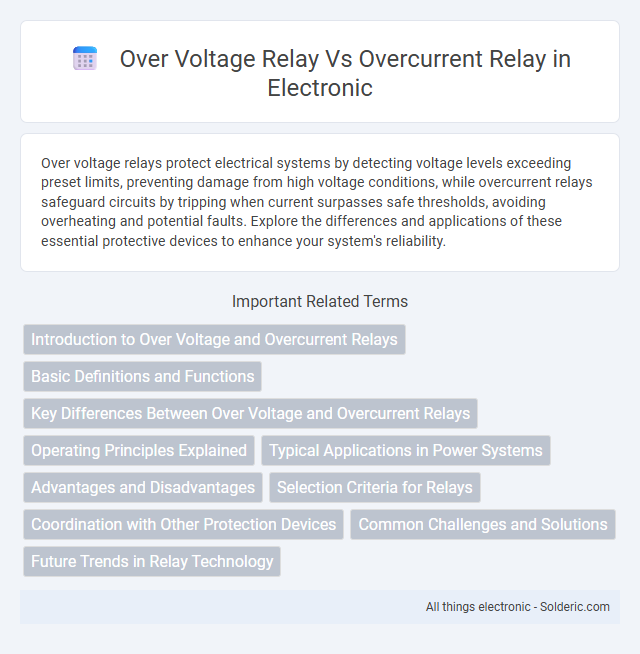Over voltage relays protect electrical systems by detecting voltage levels exceeding preset limits, preventing damage from high voltage conditions, while overcurrent relays safeguard circuits by tripping when current surpasses safe thresholds, avoiding overheating and potential faults. Explore the differences and applications of these essential protective devices to enhance your system's reliability.
Comparison Table
| Feature | Over Voltage Relay | Overcurrent Relay |
|---|---|---|
| Function | Protects equipment from voltage exceeding preset limit | Protects equipment from current exceeding preset limit |
| Protection Type | Voltage Protection | Current Protection |
| Operation Principle | Monitors line voltage and trips on overvoltage condition | Monitors line current and trips on overcurrent condition |
| Application | Switchgear, transformers, transmission lines | Generators, motors, feeders, transformers |
| Typical Setting | Set above maximum operating voltage (e.g., 110-120% of rated voltage) | Set above maximum load current (e.g., 110-120% of rated current) |
| Response Time | Moderate, based on voltage detection | Fast, immediate action on excessive current |
| Relay Type | Electromechanical or digital voltage relay | Electromechanical, solid-state, or digital current relay |
| Advantages | Prevents insulation damage due to overvoltage | Prevents overheating and damage caused by excess current |
Introduction to Over Voltage and Overcurrent Relays
Over voltage relays protect electrical equipment by detecting voltage levels that exceed preset limits, preventing insulation damage and equipment failure. Overcurrent relays operate by sensing current flow above a designated threshold, safeguarding circuits from overloads and short circuits. Both relay types are essential for maintaining system stability and preventing electrical faults in power distribution networks.
Basic Definitions and Functions
Over voltage relay monitors electrical systems for voltage exceeding preset limits, preventing damage from transient spikes or sustained overvoltage conditions by triggering protective measures. Overcurrent relay detects current flowing beyond safe thresholds caused by short circuits or overloads, promptly isolating the faulty circuit to prevent equipment damage and maintain system stability. Both relays enhance power system protection by responding to distinct electrical abnormalities, ensuring operational reliability and safety.
Key Differences Between Over Voltage and Overcurrent Relays
Over voltage relays monitor voltage levels and operate when voltage exceeds a preset threshold, protecting equipment from voltage surges. Overcurrent relays detect excessive current flow caused by overloads or short circuits, safeguarding circuits by tripping breakers when current surpasses defined limits. The key difference lies in their sensing parameters: over voltage relays focus on voltage anomalies, while overcurrent relays respond to abnormal current conditions for system protection.
Operating Principles Explained
Overvoltage relays detect abnormal voltage levels by continuously monitoring the electrical potential and triggering protection when these exceed preset thresholds, ensuring system safety against voltage surges. Overcurrent relays operate by measuring the current flow and activating when it surpasses a defined limit, providing protection against excessive current that can damage equipment. Your choice between these relays depends on the specific protection need--voltage anomalies versus current overloads--defined by their distinct operating principles.
Typical Applications in Power Systems
Over voltage relays are typically employed in power systems to protect equipment from voltage surges caused by lightning, switching operations, or faults, safeguarding transformers, generators, and transmission lines. Overcurrent relays are widely used for detecting excessive current due to short circuits or overloads, ensuring the protection of feeders, transformers, and motors by isolating faulty sections quickly. Both relay types are crucial for maintaining system stability, with over voltage relays preventing insulation damage and overcurrent relays minimizing equipment overheating and faults.
Advantages and Disadvantages
Over voltage relays protect electrical systems by detecting voltage levels exceeding set thresholds, offering the advantage of preventing insulation damage and equipment failure from voltage surges, but they may trigger false alarms due to transient voltage spikes. Overcurrent relays safeguard circuits by monitoring current flow above rated limits, effectively protecting against short circuits and overloads, though they can sometimes cause unnecessary trips during inrush currents. Your choice between these relays depends on the specific protection needs and system characteristics, balancing sensitivity and selectivity for optimal performance.
Selection Criteria for Relays
Selection criteria for over voltage relays emphasize voltage thresholds, response times, and system voltage ratings to protect equipment from abnormal voltage levels. Overcurrent relay selection prioritizes current rating, fault current capacity, time-current characteristics, and coordination with upstream and downstream protection devices. Accurate system analysis and application-specific requirements determine the optimal relay choice for reliable electrical system protection.
Coordination with Other Protection Devices
Over voltage relays coordinate with transformers and surge arresters to protect electrical systems from abnormal voltage spikes, ensuring system stability and equipment safety. Overcurrent relays work in tandem with circuit breakers and fuses to isolate faults caused by excessive current, preventing damage and maintaining power quality. Your protection strategy benefits from combining both relay types for comprehensive fault detection and coordination within the power network.
Common Challenges and Solutions
Overvoltage relays often face challenges such as sensitivity to transient voltage spikes, which can cause false tripping, while overcurrent relays may struggle with distinguishing between temporary overloads and persistent faults, leading to either nuisance trips or delayed fault isolation. Solutions for overvoltage relays include implementing time delays and filtering techniques to ignore momentary voltage surges, whereas overcurrent relays benefit from adaptive settings and inverse time characteristics to accurately differentiate fault conditions. Both relay types require regular calibration and testing to maintain reliability and proper coordination within power protection systems.
Future Trends in Relay Technology
Future trends in relay technology emphasize integration of smart grid capabilities, with overvoltage relays incorporating advanced voltage monitoring and predictive analytics to prevent electrical faults. Overcurrent relays are evolving to feature adaptive protection algorithms and real-time data communication, enhancing fault detection accuracy and system reliability. Your power systems will benefit from these advancements by experiencing improved operational efficiency and reduced downtime through intelligent relay solutions.
over voltage relay vs overcurrent relay Infographic

 solderic.com
solderic.com